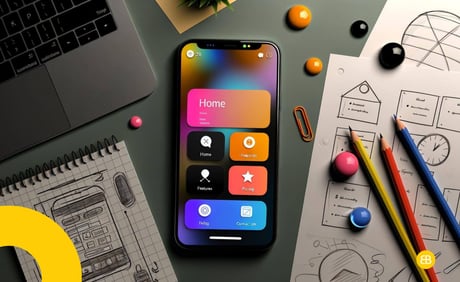Table of Contents
Are you considering developing an app for your business but feeling a bit lost when it comes to understanding the costs involved? Don’t worry! The app development world can seem a bit mysterious, but we’re here to help clear things up. In this guide, we’ll take a closer look at what drives app development costs and what you should know to make informed decisions.
Whether you’re a small startup or a well-established enterprise, getting a grip on the factors that affect app development costs is crucial. From the complexity of your app to the platform it will run on, every element plays a part in shaping the final price tag.
So, let’s dive in together and demystify the app development cost process. By the end of this article, you’ll be well-equipped with the knowledge you need to navigate the app development landscape confidently.
Factors That Influence App Development Costs

When it comes to app development, a few key factors significantly impact overall costs. One of the primary ones is the complexity of the app itself. Apps can range from simple, single-feature applications to more sophisticated platforms that integrate multiple functionalities like real-time data processing, user authentication, and social media integration. Naturally, the more advanced the features, the higher the development costs.
For example, a straightforward app with basic functionalities may take less time and fewer resources to develop. In contrast, a complex app may require a larger team and a longer development timeline, which directly impacts your budget.
The platform you choose to develop for is another important consideration. Deciding between iOS, Android, or a cross-platform solution can have a significant effect on costs. Developing a native app for each platform often means maintaining separate codebases and teams, which can ramp up expenses. On the flip side, a cross-platform app allows developers to write code once and deploy it across multiple platforms, potentially saving costs. Just keep in mind that this approach might involve some compromises in performance and user experience, which can affect ongoing costs for maintenance and updates.
Geography is also a crucial factor in app development costs. Rates can vary dramatically depending on where your development team is located. Companies in North America and Western Europe tend to charge higher rates compared to teams in Eastern Europe, India, or Southeast Asia. While choosing a more affordable development team might save you money upfront, consider potential trade-offs in quality, communication, and time zone differences that might come with remote teams.
Understanding the Different Types of App Development Pricing Models

Navigating the various pricing models for app development is essential for effectively managing your budget. The most common pricing models include fixed price, time and materials, and dedicated team models.
The fixed-price model is pretty straightforward: you and the developers agree on a set price for the entire project. This model works best for projects with well-defined requirements and timelines. However, if the project scope changes, be prepared for additional costs.
On the other hand, the time and materials model offers more flexibility. Here, costs are based on the actual time developers spend and the materials used during development. This model is ideal for projects with evolving requirements, as it accommodates changes more easily. Just be mindful that it can lead to unpredictable budgeting, so keeping an eye on progress is key to avoiding overruns.
Lastly, the dedicated team model involves hiring a team of developers for a set period. This option is great for long-term projects needing ongoing development and support. With a dedicated team, you benefit from continuity and expertise. However, be cautious—if not managed properly, this model can lead to higher costs, especially if the project scope expands beyond initial expectations.
Average Costs for App Development
Understanding the average costs associated with app development can help you set realistic expectations. While the total cost can vary widely based on factors like complexity, platform, and geography, industry estimates provide a rough benchmark. For instance, a simple app with basic functionality may set you back between $20,000 and $50,000. In contrast, a more complex app with multiple features could range from $50,000 to $100,000 or more. If you’re looking at high-end applications or those needing advanced technologies like augmented reality or artificial intelligence, be prepared for costs exceeding $150,000.
Don’t forget about ongoing costs beyond the initial development phase! Maintenance, updates, and support are crucial for keeping your app functional and relevant. Generally, businesses should allocate about 15% to 20% of the initial development cost annually for maintenance. This covers bug fixes, updates for new operating system versions, and adding features based on user feedback. Failing to budget for these ongoing costs can lead to declines in app performance and user satisfaction over time.
Marketing expenses are another important consideration when budgeting for your app. Creating a fantastic app is only part of the equation; you also need to effectively launch and promote it. Marketing costs can range from a few hundred to several thousand dollars, depending on your strategies—think social media ads, search engine optimisation, and influencer partnerships. So, when calculating your total investment in app development, don’t forget to factor in marketing costs for successful user acquisition and retention.
Hidden Costs to Be Aware Of When Working with App Development Companies

While the visible costs of app development can be clear, hidden costs can sometimes catch businesses off guard. One significant hidden cost is related to project scope changes. As development progresses, clients may realise that their initial requirements are lacking or need adjustments based on user feedback. These changes can lead to increased costs, especially under a fixed-price model where any scope change typically requires renegotiation and additional fees.
Another hidden cost is tied to testing and quality assurance. Many businesses underestimate the importance of thorough testing, which is essential for delivering a high-quality app. If your initial budget doesn’t include an adequate testing phase, the costs associated with fixing bugs and ensuring proper functionality post-launch can escalate quickly. Investing in comprehensive testing upfront can save you money in the long run.
Also, don’t overlook ongoing maintenance and support! After launching the app, continuous updates, bug fixes, and feature enhancements are vital for keeping your app competitive. Many businesses fail to allocate enough funds for these ongoing requirements, leading to deteriorating app performance and user dissatisfaction. Make it a priority to include a budget for maintenance from the outset to avoid unexpected costs later on.
Tips for Budgeting and Managing App Development Costs
Effective budgeting and cost management are key to successful app development. Start by establishing a clear project scope and requirements. Defining what features and functionalities are necessary can help reduce the risk of scope creep, which can lead to increased costs. Collaborate with stakeholders to gather input and prioritise features, ensuring your budget aligns with your project goals.
Conducting thorough market research is also a wise move. Understanding the competitive landscape and user expectations can inform your decisions about which features are truly necessary. This research helps prevent unnecessary expenditures on features that may not deliver significant value to users. By concentrating on core functionalities that address user needs, businesses can optimise their budgets and ensure a higher return on investment.
Lastly, keep communication lines open with your development team. Regular updates on project progress, challenges, and potential cost implications help ensure everyone is on the same page. Building a collaborative relationship with your developers fosters transparency and allows for proactive problem-solving, which can mitigate risks and keep your project on track.
How to Choose the Right App Development Company for Your Project
Choosing the right app development company is a pivotal decision that can significantly influence the success of your project. One key factor to consider is the company’s portfolio. Reviewing past projects can give you insights into their expertise, quality of work, and ability to meet deadlines. A well-rounded portfolio that showcases diverse projects demonstrates adaptability and a range of skills, which can be beneficial for your specific app requirements.
Another crucial aspect to evaluate is the company’s communication and project management practices. Effective communication is vital for a successful partnership, ensuring both parties are aligned on objectives and expectations. Look for companies that prioritise transparency and provide structured project management processes, including regular updates and feedback loops. This approach can facilitate a smoother development process and prevent misunderstandings that might lead to additional costs.
Finally, consider the company’s approach to post-launch support and maintenance. Your app will require ongoing updates and improvements to remain competitive, so selecting a development partner that offers robust support services is essential. Inquire about their maintenance packages, response times for issues, and commitment to long-term collaboration. A company that values client relationships and offers solid post-launch support can be an invaluable asset as your app evolves.
Case Studies: Examples of Successful App Development Projects Within Different Budgets
Looking at case studies of successful app development projects can provide valuable insights and inspiration for businesses across various budget ranges. For example, a small startup with a budget of $10,000 successfully launched a simple yet effective task management app. By focusing on core functionalities and using low-cost marketing strategies, they achieved significant user adoption and were able to reinvest profits into further development.
On the other end of the spectrum, a medium-sized business with a budget of $100,000 developed a comprehensive e-commerce platform. By collaborating with an experienced development team, they implemented advanced features like user personalisation, real-time inventory tracking, and secure payment processing. Their investment paid off, resulting in increased sales and customer engagement that justified the initial costs.
Lastly, a large enterprise with a budget exceeding $500,000 embarked on a complex app that integrated machine learning capabilities for data analysis. This significant investment allowed them to create a cutting-edge solution that provided valuable insights to users. The app not only enhanced their service offerings but also positioned them as a leader in their industry, showcasing that substantial investments can yield impressive returns when executed effectively.
Alternative Options for App Development on a Tight Budget

If you’re operating on a tight budget, exploring alternative options for app development is essential. One approach is to consider MVP (Minimum Viable Product) development. This strategy involves creating a simplified version of your app that includes only the essential features needed to test the market and gather user feedback. By launching an MVP, you can validate your idea before investing in full-scale development, potentially saving costs and ensuring that your final product aligns with user expectations.
Another option is to explore no-code or low-code development platforms. These tools allow users to create apps with minimal coding knowledge, enabling businesses to develop basic applications without significant investment. While this approach may not offer the same level of customisation or scalability as traditional development methods, it can be an excellent way to test ideas and engage users before committing to more extensive development efforts.
Additionally, consider leveraging freelance developers or smaller development teams. Often, these professionals can provide competitive rates and a more personalised approach compared to larger firms. However, it’s important to thoroughly vet freelancers or small teams to ensure they have the necessary skills and experience to deliver quality results.
FAQs
What is the average cost of developing an app?
What factors influence app development costs?
Are there hidden costs in app development?
How can I manage app development costs effectively?
What should I look for in an app development company?
Conclusion
Understanding app development costs is essential for making informed decisions about your project. By considering the factors that influence costs, exploring different pricing models, and being mindful of hidden expenses, you can set yourself up for success. Remember, thorough planning and open communication with your development team will go a long way in managing your budget effectively.
At EB Pearls, we’re committed to guiding you through the app development journey, ensuring your project aligns with your vision and budget. Ready to unlock the potential of your app idea? Let’s chat and bring your vision to life!

Akash, COO at EB Pearls, blends technical expertise with business acumen, driving the creation of successful products for clients.
Read more Articles by this Author
